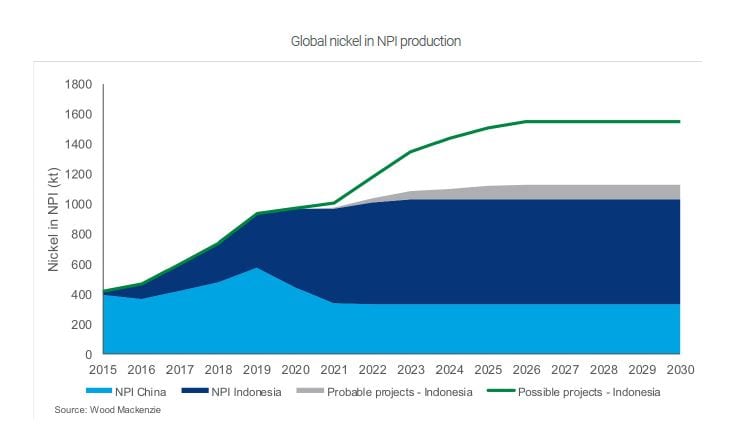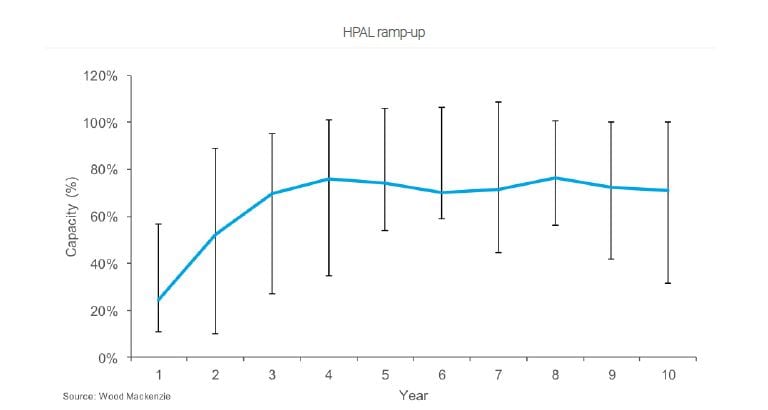The ability of the nickel market to excite investors and developers – only to then shoot itself in the foot – is second-to-none in the metal industry.
Looking back at the early 2000s, when everyone could see the massive growth potential for nickel consumption being offered by the developments in China, there were a raft of new projects progressed to provide the requiredv nickel to this new arena.
We had VNC (then Goro), Koniambo, Barro Alto, Onca Puma, Ravensthorpe, Ambatovy and Ramu – all of which have ultimately come to fruition with varying degrees of success. But all were too late to feed the growing Chinese stainless industry when it needed it most. Therefore, China had to go it alone and, out of this adversity, nickel pig iron (NPI) was born. Pandora’s Box was well and truly open.
Such was the growth in NPI production and the fact that all aforementioned projects finally commenced operating, the nickel market was essentially in surplus from 2007 through to 2016. It’s worth noting that this did not prevent the nickel price from performing its usual volatility dance over that period. Although 2007 was the zenith, with prices averaging $37,000/t for the year, the nadir was obviously 2016 when the market finally turned to deficit. The nickel market has never been one to follow fundamentals of supply and demand dynamics.
Fast-forward to October 2017 and the nickel community was once again getting very excited about the new demand growth area – electric vehicles (EVs). The euphoria was palpable during the annual gathering of the metals world in London for LME week.
Nickel was once again flavour of the month. Forecasts for nickel required to supply the EV revolution rose with every sip from the wine glass and so did the nickel price. At the start of the week, the nickel price was $11,490/t and by the end of the week it was $12,800/t. Nothing had changed fundamentally, just the perception and that was enough to provoke interest in nickel once more.

However, once everyone sobered up the following week and realised that the EV story was a long-term one, the price rapidly returned to around $11,000/t by the end of the year.
‘So what’ I hear you cry, ‘that’s old news’. What does the nickel market have in store for the future? Well, I refer the reader to my comments in the first paragraph.
The surprising news in October 2019 that Indonesia would once more ban nickel exports, two years ahead of the originally proposed date, was viewed as fantastic news for the market – so much so that nickel prices shot up $2,000/t in hours.
Surely this would lead to cuts in Chinese NPI production, push prices higher and potential project developers would have banks falling over themselves to lend money and develop the muchneeded projects to feed the looming demand for EVs? What could possibly go wrong?
Firstly, the impact of the ore ban will not be immediate. Ultimately, Chinese NPI production rates will decline over the next couple of years. However, in the meantime, development of domestic smelting capacity in Indonesia has occurred at an eyewatering pace. From its inception in 2013, with production from a few modest blast furnaces, we have seen the development of industrial parks, most notably in Morowali through Tsingshan and presently at Weda Bay. With these has come the capability to add new capacity very rapidly (build within 12 months and be operating at capacity within three) and we expect nickel in NPI production in Indonesia to reach over 520kt this year. This will more than offset the expected decline in production in China.
Secondly, with NPI has come stainless steel. Capacity in Indonesia currently stands at 3Mt/a for Tsingshan in IMIP and 600kt/a for Delong. This stainless seemingly has very low production costs and Tsingshan lowered its production rates in China and started to import its material from Indonesia to increase margins.
However, this was met with some displeasure by its competitors in China and the Chinese government was forced to place anti-dumping duties on Indonesian stainless. As such, Tsingshan has been forced to look to a more global arena to sell. Here too it has been met with safeguarding and anti-dumping measures across the globe. Now nickel’s primary market – stainless steel – is in jeopardy because of over capacity and competition from cheap imports.
We still expect nickel demand in stainless to rise, at around 1.5% per annum over the next decade, but growth will be tempered somewhat by the expected increase in use of scrap in China and the need to rationalise current capacity. For now, it appears unlikely that Tsingshan will be able to fully utilise its 3Mt/a capacity in Indonesia. Delong, one would imagine, will face similar issues in placing its material into the market once it starts to produce in earnest.
Thirdly, the knight in shining armour of demand growth in EVs, and the question of where all the high purity nickel was going to come from, also came under threat from Indonesia. Once again, it was Tsingshan which announced it was to participate in the construction of a high pressure acid leach plant (HPAL) in Morowali. This was to be a 50kt Ni/a plant to be built for US$700M and would be operational within 12 months.
Given the track record of HPAL is one of significant capital expenditure (ca. US$60-100k/t Ni/a), taking several years to construct and then at least four years to get anywhere near capacity, this bold announcement came as a shock. Had it been anyone other than Tsingshan, it would probably have been dismissed with a wry smile and given no more attention. However, because it was Tsingshan, with its track record of delivering on promises, everyone took a step back and wondered if this was game over for nickel. Just like NPI, HPAL plants would proliferate and we would be awash with nickel sulphate for batteries.
While the capex was always optimistic, it didn’t really matter. What had been announced was an intention to do it – and it would get built. The timeframe for construction was possible but also bullish. However, achieving a rapid ramp-up to capacity and beating chemistry was always going to be beyond even Tsingshan in our view.
HPAL plants are complex beasts and understanding the ore body is key. Not the nickel per se but the “stuff” which has the nickel in it – the magnesia, the silica, the iron and the chrome, etc. This is the bulk of the ore feed and it
is this that controls acid consumption, leaching rates and scaling. Understand the “stuff” and there’s a good chance of obtaining a consistent feed blend to the autoclave and a good chance of producing nickel in a steady fashion.
While we have no doubt the Tsingshan partnered plant, PT QMB New Energy, will come to fruition, as will the two subsequently announced HPAL plants being built by Huayou Cobalt and Ningbo Lygend, all will take time to ramp-up to anywhere near capacity.
Proliferation will be limited because of issues associated with waste disposal. HPAL produces around 1.4-1.6 tonnes of waste for every tonne of ore processed. It’s not a solid inert slag like that from NPI smelting – its wet and runny. So, the options are deep sea tailing disposal or dewatering and on-land storage. Neither of these appear particularly attractive given environmental considerations and the fact that Indonesia is a seismically active area. Therefore, any land-based disposal site will need to be chosen carefully.
So, perhaps the threat of Chinese-built HPAL plants in Indonesia producing the nickel required for EVs is not as great as first feared and we really can look forward to higher nickel prices providing an impetus for new nickel project developments around the world.
We can but hope but the sound of a pistol being cocked never seems far away.
Addendum: This article was written before the coronavirus pandemic began its inexorable impact on the world, its health, its economy and commodities. To put into context the impact of the pandemic on the nickel market, our forecast global demand growth for 2020 at the end of 2019 was +2.5% to reach 2.5Mt, with refined production growth of 5.4% to reach 2.54Mt. As of the end of Q1 2020, these figures indicate a decline in global consumption of 0.8% to 2.4Mt and 0% growth in refined output at 2.42Mt. A net decline of 4% in both supply and demand since the start of the year. Clearly the situation is still evolving but a global recession appears likely and further cuts in supply and demand are almost inevitable in the coming months.













